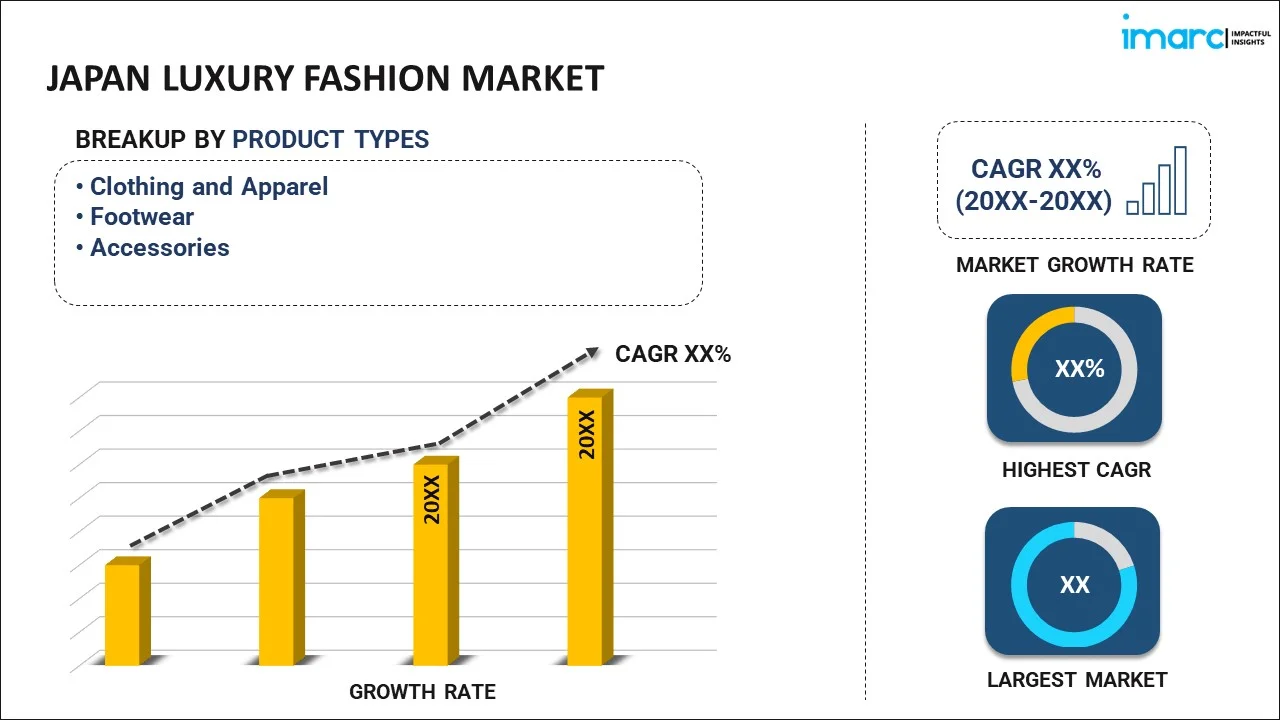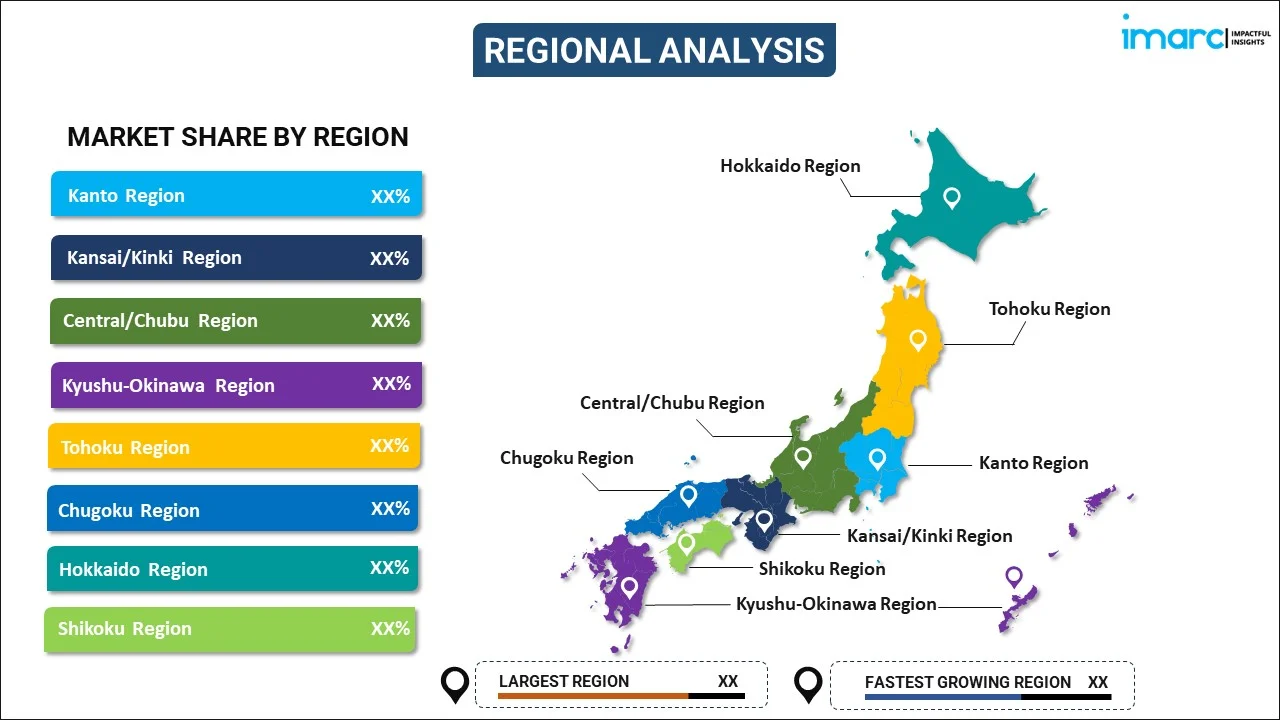
Japan Luxury Fashion Market Report by Product Type (Clothing and Apparel, Footwear, Accessories), Distribution Channel (Store-Based, Non-Store Based), End User (Men, Women, Unisex), and Region 2025-2033
Market Overview:
Japan luxury fashion market size reached USD 6.5 Billion in 2024. Looking forward, IMARC Group expects the market to reach USD 10.7 Billion by 2033, exhibiting a growth rate (CAGR) of 5.3% during 2025-2033. The increasing application of augmented reality (AR) and virtual reality (VR) technologies that offer immersive shopping experiences and virtual try-ons, appealing to tech-savvy consumers, is primarily driving the market.
|
Report Attribute
|
Key Statistics
|
|---|---|
|
Base Year
|
2024 |
|
Forecast Years
|
2025-2033
|
|
Historical Years
|
2019-2024
|
| Market Size in 2024 | USD 6.5 Billion |
| Market Forecast in 2033 | USD 10.7 Billion |
| Market Growth Rate (2025-2033) | 5.3% |
Luxury fashion refers to high-end clothing, accessories, and designs that embody exclusivity, craftsmanship, and prestige. It is characterized by impeccable quality, attention to detail, and a strong emphasis on brand heritage and image. Luxury fashion brands often use premium materials and employ skilled artisans to create unique and meticulously crafted pieces. Luxury fashion is associated with a sense of aspiration and status, appealing to individuals who value sophistication and a distinctive sense of style. These brands frequently employ iconic logos and symbols to signify their exclusivity and allure. Pricing for luxury fashion items is typically steep, reflecting the brand's prestige and the cost of superior materials and craftsmanship. Consumers of luxury fashion often view these purchases as investments in both style and social standing. Luxury fashion houses play a significant role in shaping fashion trends and setting the standard for elegance and innovation in the industry. Ultimately, luxury fashion transcends mere clothing, becoming a symbol of refined taste and social distinction.
Japan Luxury Fashion Market Trends:
The luxury fashion market in Japan is driven by a multitude of factors that together create a dynamic and ever-evolving industry landscape. Firstly, consumer preferences, which are constantly shifting, play a pivotal role. Consumers seek not only high-quality products but also unique and exclusive designs that reflect their individuality. This demand for uniqueness leads to the emergence of new trends and styles. Moreover, digitalization has significantly impacted the luxury fashion market. The rise of e-commerce platforms and social media has allowed brands to reach audiences and engage with consumers in novel ways. Additionally, sustainability has become a major driver. Ethical and environmentally responsible practices are increasingly valued by consumers. Luxury fashion brands are adapting by incorporating sustainable materials, ethical sourcing, and transparent supply chains into their operations. Furthermore, the rising incomes and a growing middle class in Japan have created a new wave of luxury consumers. In conclusion, the luxury fashion market is shaped by an intricate interplay of consumer preferences, digitalization, sustainability concerns, and the influence of emerging markets, making it a dynamic and highly competitive industry.
Japan Luxury Fashion Market Segmentation:
IMARC Group provides an analysis of the key trends in each segment of the market, along with forecasts at the country level for 2025-2033. Our report has categorized the market based on product type, distribution channel, and end user.
Product Type Insights:

- Clothing and Apparel
- Jackets and Coats
- Skirts
- Shirts and T-Shirts
- Dresses
- Trousers and Shorts
- Denim
- Underwear and Lingerie
- Others
- Footwear
- Accessories
- Gems and Jewellery
- Belts
- Bags
- Watches
The report has provided a detailed breakup and analysis of the market based on the product type. This includes clothing and apparel (jackets and coats, skirts, shirts and t-shirts, dresses, trousers and shorts, denim, underwear and lingerie, and others), footwear, and accessories (gems and jewellery, belts, bags, and watches).
Distribution Channel Insights:
- Store-Based
- Non-Store Based
A detailed breakup and analysis of the market based on the distribution channel have also been provided in the report. This includes store-based and non-store based.
End User Insights:
- Men
- Women
- Unisex
The report has provided a detailed breakup and analysis of the market based on the end user. This includes men, women, and unisex.
Regional Insights:

- Kanto Region
- Kansai/Kinki Region
- Central/ Chubu Region
- Kyushu-Okinawa Region
- Tohoku Region
- Chugoku Region
- Hokkaido Region
- Shikoku Region
The report has also provided a comprehensive analysis of all the major regional markets, which include Kanto Region, Kansai/Kinki Region, Central/ Chubu Region, Kyushu-Okinawa Region, Tohoku Region, Chugoku Region, Hokkaido Region, and Shikoku Region.
Competitive Landscape:
The market research report has also provided a comprehensive analysis of the competitive landscape in the market. Competitive analysis such as market structure, key player positioning, top winning strategies, competitive dashboard, and company evaluation quadrant has been covered in the report. Also, detailed profiles of all major companies have been provided.
Japan Luxury Fashion Market Report Coverage:
| Report Features | Details |
|---|---|
| Base Year of the Analysis | 2024 |
| Historical Period | 2019-2024 |
| Forecast Period | 2025-2033 |
| Units | Billion USD |
| Scope of the Report | Exploration of Historical and Forecast Trends, Industry Catalysts and Challenges, Segment-Wise Historical and Predictive Market Assessment:
|
| Product Types Covered |
|
| Distribution Channels Covered | Store-Based, Non-Store Based |
| End Users Covered | Men, Women, Unisex |
| Regions Covered | Kanto Region, Kansai/Kinki Region, Central/ Chubu Region, Kyushu-Okinawa Region, Tohoku Region, Chugoku Region, Hokkaido Region, Shikoku Region |
| Customization Scope | 10% Free Customization |
| Post-Sale Analyst Support | 10-12 Weeks |
| Delivery Format | PDF and Excel through Email (We can also provide the editable version of the report in PPT/Word format on special request) |
Key Questions Answered in This Report:
- How has the Japan luxury fashion market performed so far and how will it perform in the coming years?
- What has been the impact of COVID-19 on the Japan luxury fashion market?
- What is the breakup of the Japan luxury fashion market on the basis of product type?
- What is the breakup of the Japan luxury fashion market on the basis of distribution channel?
- What is the breakup of the Japan luxury fashion market on the basis of end user?
- What are the various stages in the value chain of the Japan luxury fashion market?
- What are the key driving factors and challenges in the Japan luxury fashion?
- What is the structure of the Japan luxury fashion market and who are the key players?
- What is the degree of competition in the Japan luxury fashion market?
Key Benefits for Stakeholders:
- IMARC’s industry report offers a comprehensive quantitative analysis of various market segments, historical and current market trends, market forecasts, and dynamics of the Japan luxury fashion market from 2019-2033.
- The research report provides the latest information on the market drivers, challenges, and opportunities in the Japan luxury fashion market.
- Porter's five forces analysis assist stakeholders in assessing the impact of new entrants, competitive rivalry, supplier power, buyer power, and the threat of substitution. It helps stakeholders to analyze the level of competition within the Japan luxury fashion industry and its attractiveness.
- Competitive landscape allows stakeholders to understand their competitive environment and provides an insight into the current positions of key players in the market.
Need more help?
- Speak to our experienced analysts for insights on the current market scenarios.
- Include additional segments and countries to customize the report as per your requirement.
- Gain an unparalleled competitive advantage in your domain by understanding how to utilize the report and positively impacting your operations and revenue.
- For further assistance, please connect with our analysts.
 Request Customization
Request Customization
 Speak to an Analyst
Speak to an Analyst
 Request Brochure
Request Brochure
 Inquire Before Buying
Inquire Before Buying




.webp)




.webp)












